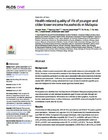| dc.identifier.citation | Rizal, H., Said, M. A., Majid, H. A., Su, T. T., Pin, T. M., Ismail, R., & Zaidi, M. A. S. Health-related quality of life of younger and older lower-income households in Malaysia. Plos one, 17(2), e0263751. https://doi.org/10.1371/journal.pone.0263751 | en |
| dc.description.abstract | Background: Globally, a lower income is associated with poorer health status and reduced quality of life (QOL). However, more research is needed on how being older may influence QOL in lower-income households, particularly as older age is associated with an increased risk of chronic diseases and care needs. To this end, the current study attempts to determine the health-related QOL (HRQOL) among individuals from lower-income households aged 60 years and over compared to lower-income adults aged less than 60 years.
Methods: Participants were identified from the Department of Statistics Malaysia sampling frame. Surveys were carried out with individual households aged 18 years and older through self-administered questionnaires. Information was collected on demographics, household income, employment status, number of diseases, and HRQOL assessed using the EuroQol 5-Dimension 5-Level (EQ-5D-5L) tool.
Results: Out of a total of 1899 participants, 620 (32.6%) were female and 328 (17.3%) were aged 60 years and above. The mean (SD) age was 45.2 (14.1) and mean (SD) household income was RM2124 (1356). Compared with younger individuals, older respondents were more likely to experience difficulties in mobility (32.1% vs 9.7%, p<0.001), self-care (11.6% vs 3.8%, p<0.001), usual activities (24.5% vs 9.1%, p<0.001), pain/discomfort (38.8% vs 16.5%, p<0.001) and anxiety/depression (21.4% vs 13.5%, p<0.001). The mean (SD) EQ-5D index scores were lower among older respondents, 0.89 (0.16) vs 0.95 (0.13), p = 0.001. After adjusting for covariates, age was a significant influencing factor (p = 0.001) for mobility (OR = 2.038, 95% CI:1.439–2.885), usual activities (OR = 1.957, 95% CI:1.353–2.832) and pain or discomfort (OR = 2.241, 95% CI:1.690–2.972).
Conclusion: Lower-income older adults had poorer HRQOL compared to their younger counterparts. This has important implications concerning intervention strategies that incorporate active ageing concepts on an individual and policy-making level to enhance the QOL and wellbeing, particularly among the older lower-income population. | en |
